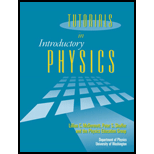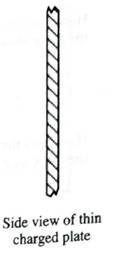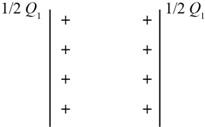
Concept explainers
A small portion near the center of a large thin
Write an expression for the charge density on each side of the conducting plate.

The expression for charge density on each side of the conducting plate.
Explanation of Solution
Introduction:
The charge density is the ratio the charge distributed over a surface area. The expression for the charge density is given by,
The distribution of the charge on the plate is shown below,

Figure 1
Now, because plate in uniform and charge on both the sides is same. So, the charge density on both the sides of the plate if the area of the sides is
Conclusion:
Therefore, the expression for the charge density on each side of the plate is
Want to see more full solutions like this?
Chapter 5 Solutions
Tutorials in Introductory Physics
Additional Science Textbook Solutions
University Physics (14th Edition)
An Introduction to Thermal Physics
Physics for Scientists and Engineers: A Strategic Approach with Modern Physics (4th Edition)
The Cosmic Perspective (8th Edition)
Essential University Physics: Volume 1 (3rd Edition)
College Physics (10th Edition)
- An insulating solid sphere of radius a has a uniform volume charge density and carries a total positive charge Q. A spherical gaussian surface of radius r, which shares a common center with the insulating sphere, is inflated starting from r = 0. (a) Find an expression for the electric flux passing through the surface of the gaussian sphere as a function of r for r a. (b) Find an expression for the electric flux for r a. (c) Plot the flux versus r.arrow_forwardThe electric field at a distance of 0.157 m from the surface of a solid insulating sphere with radius 0.361 m is 1730 N/C. Part A Assuming the sphere's charge is uniformly distributed, what is the charge density inside it? Part B Calculate the electric field inside the sphere at a distance of 0.214 mfrom the center.arrow_forwardA hemispherical surface of radius b = 16.5m is fixed in a uniform electric field of magnitude E0 = 6.47 V/m. This is illustrated in the attached image. (x - axis points out of the screen) What is the general expression for an infinitesimal area dA, is spheral coordinates (r, Θ, Φ), where Θ is the polar angle and Φ is the azimuthal angle? Use ñ as your outward pointing unit vector. Calculate the electric flux in volt meters through the hemishpere.arrow_forward
- In the figure below, a solid sphere, of radius a = 1.50 cm is concentric with a spherical conducting shell of inner radius b = 2.00a and outer radius c = 2.40a. The sphere has a net charge q1 = +3.00 fC which is distributed uniformly through the sphere; the shell has a net charge of q2 = −q1. (g) What is the net charge on the inner surface of the shell? fC(h) What is the net charge on the outer surface of the shell? fCarrow_forwardAn infinitely long conducting cylindrical rod with a positive charge λ per unit length is surrounded by a conducting cylindrical shell (which is also infinitely long) with a charge per unit length of −2λ and radius r1, as shown in the figure. A) What is E(r), the radial component of the electric field between the rod and cylindrical shell as a function of the distance r from the axis of the cylindrical rod? Express your answer in terms of λ, r, and ϵ0 the permittivity of free space. B) What is σ inner, the surface charge density (charge per unit area) on the inner surface of the conducting shell? C) What is σ outer, the surface charge density on the outside of the conducting shell? (Recall from the problem statement that the conducting shell has a total charge per unit length given by −2λ D) What is the radial component of the electric field, E(r), outside the shell?arrow_forwardConsider a hollow spherical conductive shell of radius (R) 0.2 m with a fixed charge of +2.0 x 10-6 C uniformly distributed on its surface. a. What if the sphere is a solid conductive sphere? What is the electric field at all points inside the sphere? Express your answer as function of the distance r from the center of the sphere. b. What is the electric field at all points outside the sphere? Express your answer as a function of the distance r from the center of the spherearrow_forward
- A standard coaxial cable consists of a cylindrical central conducting wire, a layer of surrounding insulation, a flexible conducting pipe-like sheath, and a final outer layer of insulation as shown in the figure. Imagine a very long straight stretch of such a wire, and suppose that the inner wire has a charge per unit length of λ and the sheath has a charge per unit lenth of -λ (where λ is a positive constant). a. Argue that the charge must reside in thin layers on the wire's outer surface and the sheath's inner surface. b. Determine Evector (in terms of R, λ, and ε0) in the regions (1) s < R, (2) R < s < 2R, and (3) s > 2R. c. Draw a quantitatively accurate graph of Er as a function of s from s = 0 to s = 3R. The graph will look discontinuous in places. Explain why this does not violate the continuity principle.arrow_forwardConsider two thin disks, of negligible thickness, of radius R oriented perpendicular to the x axis such that the x axis runs through the center of each disk. The disk centered at x=0 has positive charge density η, and the disk centered at x=a has negative charge density −η, where the charge density is charge per unit area. What is the magnitude E of the electric field at the point on the x axis with x coordinate a/2? Express your answer in terms of η, R, a, and the permittivity of free space ϵ0.arrow_forwarda through c please A charge of -90.4 uC is placed on spherical conductor of radius 10.0 cm. Part (a) What is the magnitude, in newtons per coulmb, of the electric field due to this charge at a distance of 1.32 cm from the center of the sphere? Give your answer in N/C. Part (b) What is the magnitude, in newtons per coulmb, of the electric field due to this charge at a distance of 7.08 cm from the center of the sphere? Give your answer in N/C. Part (c) What is the magnitude, in newtons per coulmb, of the electric field due to this charge at a distance of 17.1 cm from the center of the sphere. Give your answer in N/C.arrow_forward
- A nonuniform, but spherically symmetric, distribution of charge has a charge density ρ(r) given as follows: ρ(r)= ρ 0 (1−4r/3R) for r≤R ρ(r)=0 for r≥R where R and ρ 0 are positive constants.Part D Find the value of r at which the electric field is maximum. Express your answer in terms of the variables r , R , ρ 0 , and appropriate constants. Part E Find the value of that maximum field. Express your answer in terms of the variables r , R , ρ 0 , and appropriate constants. Part d and E, please.arrow_forwardThe charge per unit length on the thin rod shown below is λ.λ. What is the electric force on the point charge q? Solve this problem by first considering the electric force dF⃗ dF→ on q due to a small segment dxdx of the rod, which contains charge λdx.λdx. Then, find the net force by integrating dF⃗ dF→ over the length of the rod.arrow_forwardPositive electric charge is uniformly distributed along the y-axis with a linear charge density l. Consider the case where charge is distributed only between points y = +a and y = -a. For points between the +x-axis, graph the x-component of the electric field as a function of x, Ex (x), for values x = a/2 and x = 4a. Consider instead the case where charge is distributed along the entire y-axis with the same charge density l. Using the same graph as in part (a), plot the x-component of the electric field, Ex (x), as function of x for values of x between x = a/2 and x = 4a.arrow_forward
 Physics for Scientists and Engineers: Foundations...PhysicsISBN:9781133939146Author:Katz, Debora M.Publisher:Cengage Learning
Physics for Scientists and Engineers: Foundations...PhysicsISBN:9781133939146Author:Katz, Debora M.Publisher:Cengage Learning Principles of Physics: A Calculus-Based TextPhysicsISBN:9781133104261Author:Raymond A. Serway, John W. JewettPublisher:Cengage Learning
Principles of Physics: A Calculus-Based TextPhysicsISBN:9781133104261Author:Raymond A. Serway, John W. JewettPublisher:Cengage Learning

